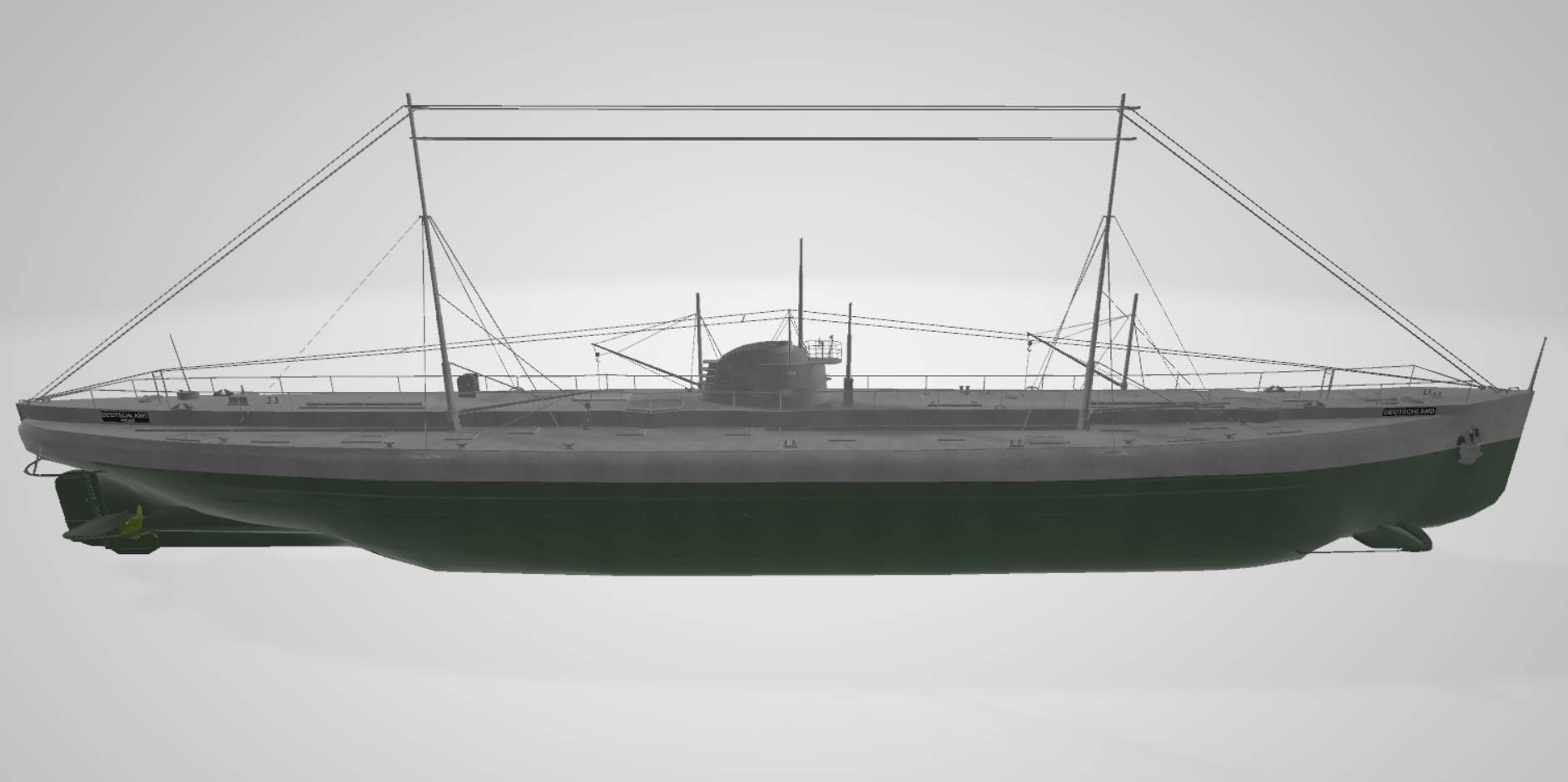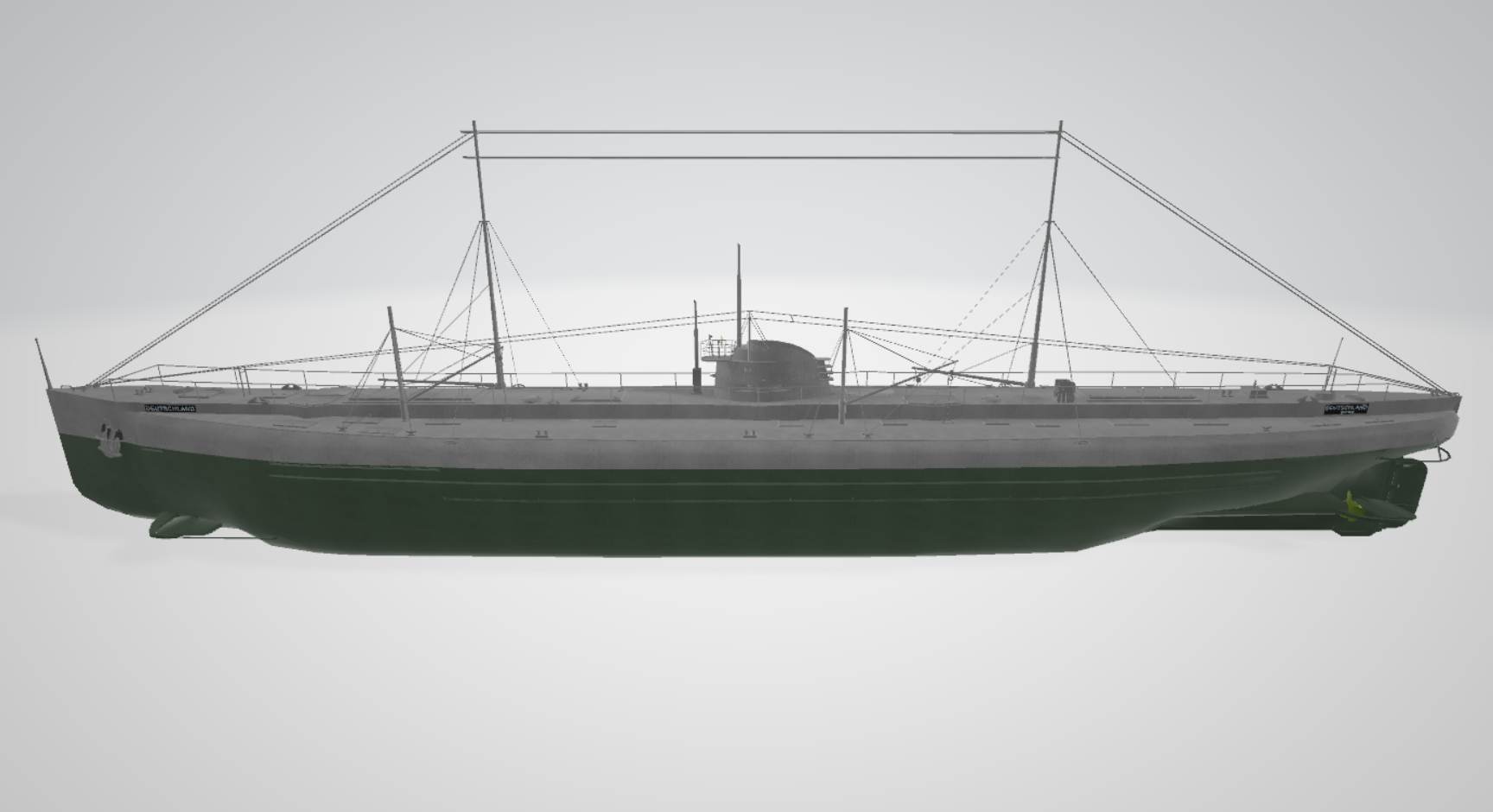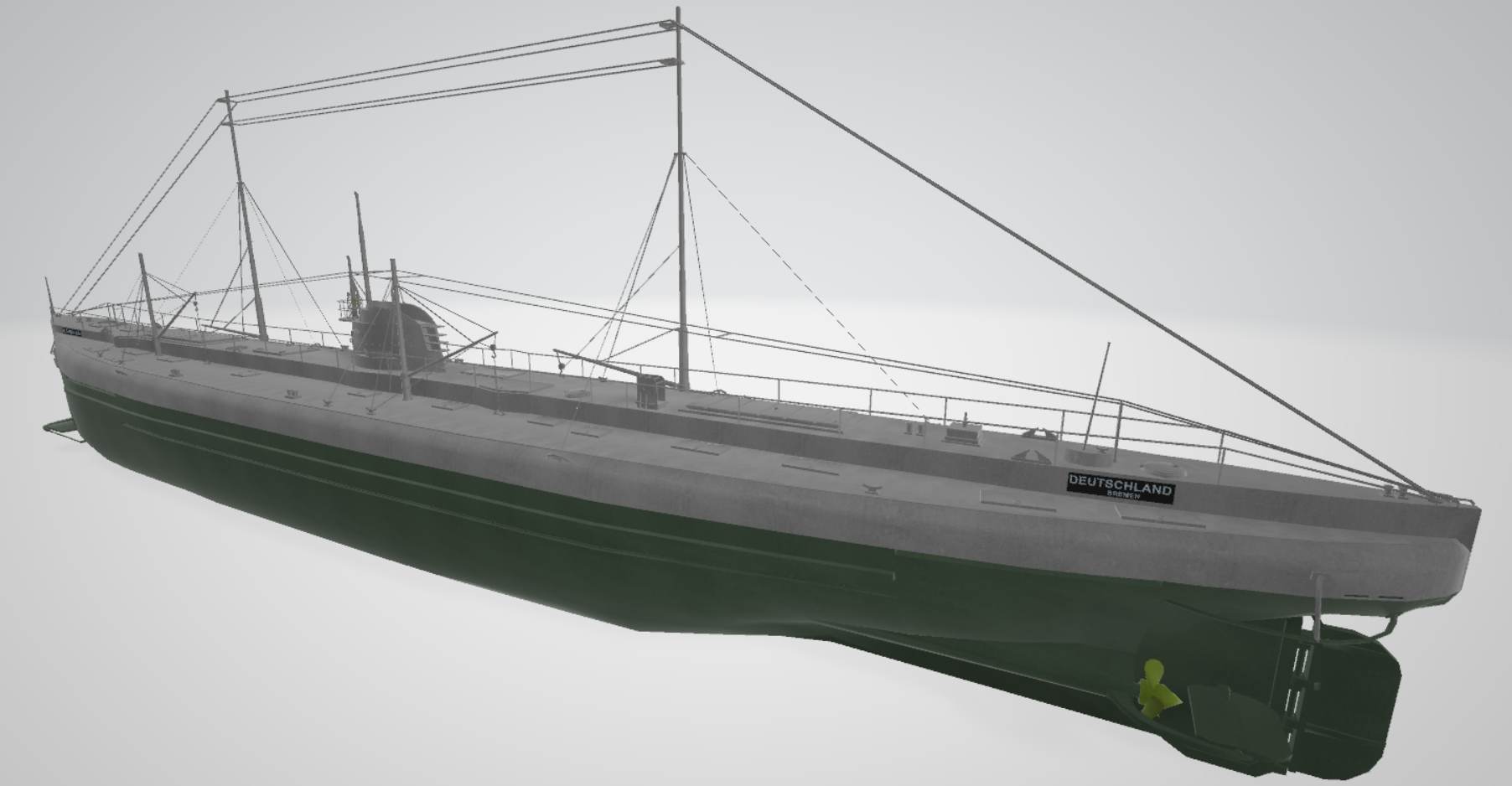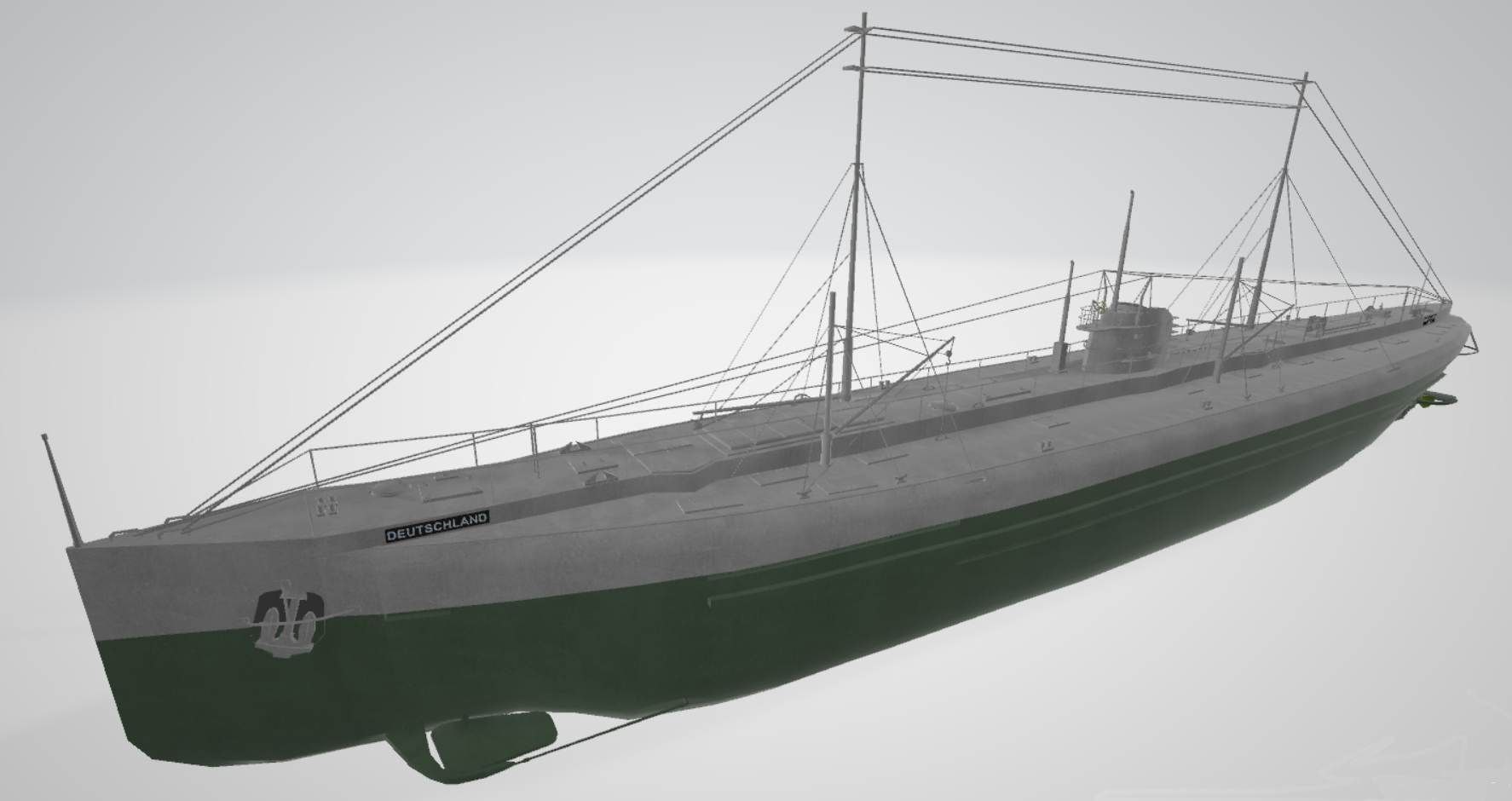SMS
Deutschland was built together with her sister ship Bremen in 1916
for the German Ocean Navigation,
it was developed with private funds and operated by the North German
Lloyd Line.
She was constructed without armaments and with a wide beam to provide
space for 700 tons cargo.
SMS Deutschland was used as a blockade-running merchant submarine
during early World War I.
She was the first of seven U-151-class U-boats built and one of only
two used as unarmed cargo submarines.
The other sister boat SMS Bremen, was lost on its maiden voyage, to
the United States.
Britain and France soon protested against the use of submarines as
merchant ships, arguing that they could not be stopped and inspected
for munitions in the same manner as other cargo vessels.
The US, under diplomatic pressure rejected the argument. Even submarines,
as long as they were unarmed, were regarded as merchant vessels and
would be permitted to trade.
After making two voyages as an unarmed merchantman, she was taken
over by the German Imperial Navy.
On 19 February 1917 she was converted into U-155 and armed with six
torpedo tubes and two deck guns.
As U-155, she began a raiding career in June 1917 that was to last
until October 1918.
She sank 120,434 tons of shipping and damaged a further 9,080 tons
of shipping.
First
merchant voyage
Deutschland departed on her first voyage to the US on 23 June 1916
commanded by Paul König, formerly of the North German Lloyd company.
On her maiden voyage, she carried 750 tons of cargo in total, including
125 tons of highly sought-after chemical dyes, mainly Anthraquinone
and Alizarine derivatives in highly concentrated form, some of which
were worth as much as $1,254 a pound in 2005. She also carried medical
drugs, gemstones, and diplomatic mails, her cargo being worth $1.5
million in total ($36 million in 2021).
Deutschland waited a week at Heligoland to avoid enemy patrols. She
submerged for only 90 miles) of the 3,800-mile (6,100 km) outbound
voyage. She did not enter the English channel but took a northern
passage around Scotland.
She arrived at the Quarantine anchorage off of Marley Neck, Anne Arundel
county, just outside of what was then Baltimore city limits, during
the late evening hours on 9 July 1916 after just over two weeks at
sea.
During their stay in Baltimore, the German crewmen were welcomed as
celebrities for their astonishing journey and even taken to fancy
dinners and an impromptu volksfest in the southwest part of the city.
American submarine pioneer Simon Lake visited Deutschland while she
was in Baltimore, and made an agreement with the North German Lloyd
line to build cargo submarines in the US, a project which never came
to fruition after the United States declared war on Germany in early
April, 1917.
She stayed at Baltimore until 2 August, when she sailed for Bremerhaven,
arriving on 24 August with a cargo of 341 tons of nickel, 93 tons
of tin, and 348 tons of crude rubber. Her cargo was valued at $17.5
million, several times the submarine's construction costs. She had
traveled 8,450 nmi having been submerged for 190 nmi of them.
Second merchant voyage
Deutschland made another round trip in November 1916 to New London,
Connecticut with $10 million of cargo including gems, securities,
and medicinal products. At the same time the submarine U-53 also crossed
the Atlantic to visit Newport, Rhode Island, and sank five Allied
freighters just outside US territorial limits before returning home.
On 17 November as she was putting to sea, Deutschland accidentally
rammed the tugboat T. A. Scott, Jr., which., sank immediately with
the loss of her entire crew of five. Deutschland's bow was damaged,
and she had to return to New London for repairs, which delayed her
departure by a week. She finally left New London on 21 November 1916,
with a cargo that included 6.5 tons of silver bullion.
Following his last voyage, Captain Paul König collaborated to
write a book about the journeys of Deutschland, entitled Voyage of
the Deutschland, the First Merchant Submarine (Verlag Ullstein &
Co, Berlin 1916, and, Hearst International Library Co., New York 1916).
The book was heavily publicized, as it was intended to sway public
opinion in both Germany and the US.
A third voyage, planned for January 1917, was aborted as German-US
relations had worsened after the sinking of shipping bound for the
United Kingdom, just outside US territorial waters.
-------
1917
Deutschland was taken over by the German Imperial Navy on 19 February
1917 and converted into U-155, part of the U-Kreuzer Flotilla, being
fitted with 6 bow torpedo tubes with 18 torpedoes, and two 15 cm SK
L/40 naval gun taken from the pre-dreadnought battleship SMS Zähringen.
She made three successful war cruises, sinking 42 ships and damaging
one.
During the summer of 1917 U-155 made a 105-day cruise, commanded by
Kptlt. Karl Meusel, leaving Germany on the 24th May and returning
on 4 September. During her Passage around the northern end of the
British Isles and into the Atlantic Ocean, she was stalked and nearly
sunk by U-19 near Utsira Island, in Norway.
During this patrol, she fired on the port city of Ponta Delgada in
the Azores on 4 July at 3 a.m. with its deck guns. The Portuguese
army units did not respond because of their obsolete artillery. The
collier USS Orion happened to be in port at the time undergoing repairs.
Its company returned U-155's fire and dueled with the German boat
for about 12 minutes. U-155 submerged without being hit and eventually
retired.
While the raid was light in damage (it killed four people), it alarmed
Allied naval authorities about the defenseless nature of the Azores
and their possible use as a base by boats like U-155 in the future.
Allied naval forces, led by the U.S. Navy, began to send ships and
establish a naval operating base in Ponta Delgada as a result.
During her patrol she sank 19 merchant ships, most by either scuttling
or gunfire. She attacked 19 Allied armed merchantmen but only succeeded
in sinking 9 of them. Upon her return to Germany she had covered a
distance of 10,220 nmi, of which 620 nmi had been travelled submerged,
one of the longest voyages made by a U-boat during World War I.
1918
U-155 sailed from Kiel on 11 August 1918 commanded by Ferdinand Studt.
Studt's orders told him to cruise off the US coast in the region of
the Nantucket lightship and lay mines off St. John's, Newfoundland
and Halifax, Nova Scotia. He was also directed to cut telegraph cables
off Sable Island, 50 miles southeast of Nova Scotia. His orders, however,
proved confusing, as Studt believed that the St. Johns where he was
to lay mines was actually Saint John, New Brunswick, in the Bay of
Fundy.
On U-155's outbound voyage she had captured and scuttled the Portuguese
sailing ship Gamo, had attempted an attack on SS France, and destroyed
by gunfire the Norwegian Stortind. On 7 September U-155 found herself
in a long range gun duel with the US steamer Frank H. Buck, with the
steamer later claiming to have sunk U-155.
On 13 September U-155 engaged in another gun fight with the British
merchantman Newby Hall, which managed to damage the submarine, denting
her armour and causing serious leaks in her pressure hull which made
diving temporarily impossible.
On 19 September, Studt tried and failed to locate and cut the telegraph
cable near Sable Island, so headed for Nantucket.
---------
U-155 returned to Germany from her final cruise on 12 November 1918
and was surrendered to the Allies at Harwich 24 November 1918 with
other submarines as part of the terms of the Armistice.
She was exhibited at St Katharine's Dock, London, in December 1918,
and then at Liverpool, before being laid up at Rosyth. There, she
was sold on 3 March 1919 to James Dredging Co. for £3,500, and
then sold-on to Noel Pemberton Billing for £17,000, and the
to John Bull Ltd (£15,000), a vehicle for Horatio Bottomley,
who demilitarised the boat and embarked on a commercial tour that
began at Great Yarmouth in September 1919, with the vessel re-christened
Deutschland.
At the end of the tour, in June 1921 she was taken into dock for stripping
at the Camel Laird shipyard Birkenhead, where, on 17 September 1921,
an explosion in the engine room killed five apprentices.
The hulk was sold to Robert Smith & Son, Birkenhead, for £200
in June 1922, and broken up at Rock Ferry, Birkenhead.
From Wikipedia,
the free encyclopedia
|





